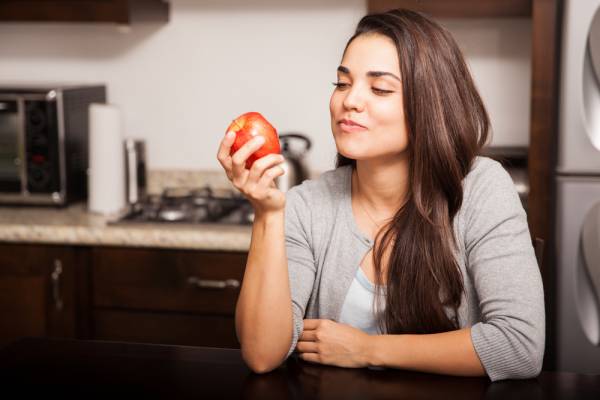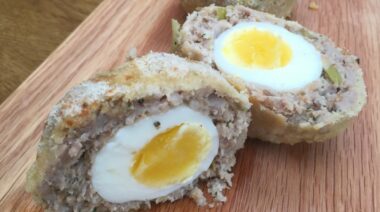I’ve always been fascinated by the Tootsie Pops’ commercial question: “How many licks does it take to get to the Tootsie Roll center of a Tootsie Pop?”
I haven’t eaten one of those things since the Halloween days of my childhood, but last I checked on the Tootsie Roll website, it was determined by a group of junior high students at Swarthmore Junior High School in Swarthmore, Pennsylvania that it took an averaged total of 144 licks to get to the center.
The Tootsie Pop experiment got me thinking about our food, and how we enjoy it. When was the last time you savored a meal, like a Tootsie Pop? When was the last time you took the time to taste the flavors, enjoy the food on your tongue, and nourish your body one bite at a time?
(Crickets. Crickets.)
That’s what I thought.
In our fast-paced, busy lifestyles, many peoples’ approach to mealtime looks something like this: chew, chew, swallow, chew, chew, swallow, guuuuulp.
So much to do, so little time. And, while this is great for getting things done – not letting mealtime get in the way of your to-do list or instantly feeding the machine when you are starving – it is not as great for your digestion.
Fun Facts About Digestion
Fun Fact: Digestion begins in your mouth. Your mouth is the place where the mechanical and chemical breakdown of your food occurs through the combined use of your masticators (i.e. jaw and teeth) and saliva.
Saliva contains enzymes critical to the chemical process of digestion. For instance, carbohydrate digestion begins with salivary alpha-amylase secreted by glands near the mouth. This alpha-amylase breaks down some of the chemical bonds connecting the simple sugars that comprise starches. Stage one of fat digestion also occurs in the mouth with the secretion of the enzyme lingual lipase by glands located at the root of the tongue.
If food is not properly broken down in the mouth, then your body has a longer way to go when it comes to digesting the foods you’ve just consumed. This is not the most efficient or effective way to feed yourself. For starters, when food is not fully chewed, you actually miss out on some of the nutrients.
“If food is not properly broken down in the mouth, then your body has a longer way to go when it comes to digesting the foods you’ve just consumed. This is not the most efficient or effective way to feed yourself.”
Additionally, any poorly chewed food also causes slowed transit time through your stomach and intestines. In fact, thorough chewing is directly connected with the relaxation of your stomach muscle – the pylorus – in order to move food through your digestive tract. This muscle must be relaxed for food to leave your stomach and pass on to your small intestine. The stimulation of saliva from optimal chewing helps relax the pylorus and aids the healthy progression of your food.
Lastly, poorly chewed food promotes bacteria build-up down the line in the colon. This leads to increased flatulence (gas), constipation, and indigestion.
The Power of Choice
Little did you know that before these autonomic processes take place, that you have the choice – and power – to determine how well you digest your food.
- Chewing thoroughly = Less indigestion. Regulated appetite. Decreased constipation and regular bowel movements. Win-win-win.
- Failing to chew thoroughly = Higher risk for stomach pain, bloating, constipation and indigestion. Poor appetite. Backed up bowels. Lose-lose-lose.

How Much Chewing Do I Need?
Okay, you get it. Chew your food. But how much? I mean it’s not like you don’t chew your steak at all. I don’t advocate a distinct number of times you should chew food. Instead, I advise people to use a more personal rule-of-thumb: chew your food completely, until it’s dissolved and small enough swallow with ease.
If you can tell the type of food you are eating from the texture in your mouth (not the taste), then you haven’t chewed enough. For instance, if you are chewing a Brussels sprout and you can still tell with your tongue that the sprout has some leaves on the outside, don’t swallow. You need to keep on chewing until you can’t distinguish the leaves from the base of the sprout. If you are chewing a piece of chicken, and it’s still in solid form, continue to gnaw on it, until it’s soft and mush like.
As gross as that may sound, your body (and your gut) will thank you.
Chew. Chew. Chew. Chew. Chew. Chew. And…swallow.
More Like This:
- Why Your Diet Can Make You Bloated (Even With Good Nutrition)
- 2 Tasty Tidbits to Get Your Best Results From Paleo
- Dissecting Anti-Nutrients: The Good and Bad of Phytic Acid
- New on Pulse Beat Fit Today
Photos courtesy of Shutterstock.






